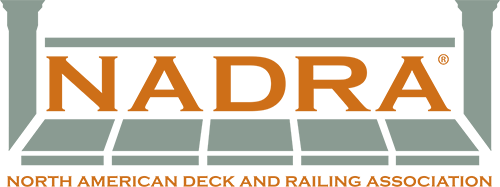March 21, 2011 | Lainie Sleppin of Mid-State Lumber asks:
“I am getting a number of calls regarding the code on deck stair
lighting, no pun but can you shed any light on this code so I can
advise correctly. We are talking about guys in the NJ market.Thanks for your help and have a great weekend.”
Glenn Mathewson, NADRA’s Technical Advisor, responds:
Hello Lainie,
Thanks for your confidence in NADRA, the voice of the decking industry, to be your “go to” when you need quality information on the decking and railing industry. I understand your contractor customers in the New York and New Jersey area have been asking questions lately about lighting at deck stairways. I am happy to provide you assistance in better understanding the requirements of the 2009 IRC in this regard. Many people I discuss this with are surprised that when you read Section R303.6 there are two requirements…one for the location of a lighting fixture, and one for the illumination of the stairway. They are not one in the same.
I have copied below the discussion from ICC’s deck code book, Deck Construction based on the 2009 IRC. As the author of this discussion, I am happy to answer any questions that you or any other folks visiting the NADRA blog may have in its regard. With a little internet research I was quickly able to find both the New Jersey and New York state residential codes. New York has retained section R303.6 of the IRC in their customized version, so the discussion below applies. Their code section can be viewed here.
I guess things are a little looser though in New Jersey, as their version of the IRC was amended with the complete removal of the stairway lighting section. For work performed in that state, the discussion below is not applicable. The deletion of Section R303.6 can be verified here.
QUOTE FROM DECK CONSTRUCTION BASED ON THE 2009 INTERNATIONAL RESIDENTIAL CODE
PUBLISHED BY: The International Code Council
AUTHORED BY: Glenn MathewsonSection R303.6 provides two requirements for illumination of exterior stairways, however, they are not contradictory and each one is separately applicable. The leading statement of this section requires that all stairs, landings and treads of all exterior stairways be provided with a “means to illuminate”. This “means” can come from any source or location, be it a flood light mounted to the existing home, or small low-voltage lights disbursed throughout all the stairway components (see Ex’s. 6-19 and 6-20). Stairs are inherently dangerous; therefore the means to illuminate them completely may help inhibit an after-dark slip and injury.
Further in the section there is a specific requirement for the location of an “artificial light source” in the immediate vicinity of the top landing. The specific requirement for a light source only at the top landing of the stairway does not eliminate the requirement for a “means to illuminate” all the stairway components. Depending on the layout of the stairs, and the location, size, type and wattage of the required upper landing light, the stairway may be illuminated in its entirety by a single light, or it may require additional light sources. When low-voltage lights are installed throughout a stairway as the “means to illuminate”, at least one light fixture must be placed at the top landing.The illumination of exterior stairways, regardless of the quantity or location of the fixtures, must be controllable from inside the dwelling. This does not mean that other illumination cannot be provided separate from the stairway illumination and controlled elsewhere, nor does it prohibit three-way or four-way switches to allow control of the stairway illumination from additional locations.
The exception to this requirement is convenient for low-voltage lighting systems commonly seen in deck construction. Stairway lighting not switched inside must be continuously illuminated or automatic. For continuous illumination a timer or photo cell can be used that would turn the lights on at dusk and off at dawn. Many low-voltage transformers allow multiple settings of the timer and photo cell in combination and can be set to turn the lights off after a predetermined period of time. While this saves the electricity of running lights throughout the entire night, it does not satisfy the IRC requirements. Motion sensors can also be used that would turn the lights on automatically when sensing a stair user approaching either a top or bottom landing. The intent of this section is to allow someone to illuminate the stairs at any hour of the night, either from inside the dwelling or automatically.


